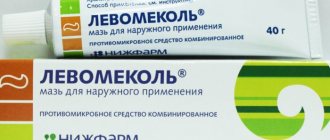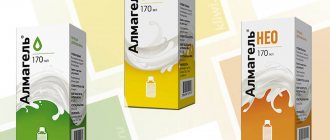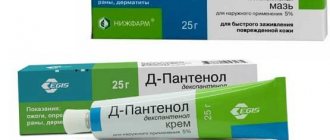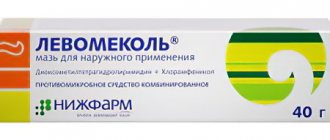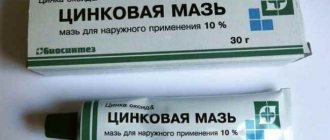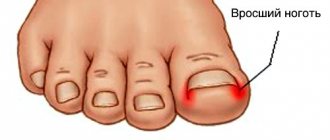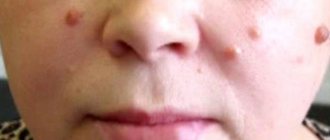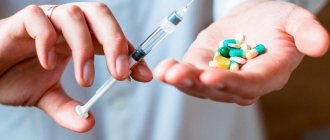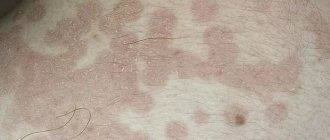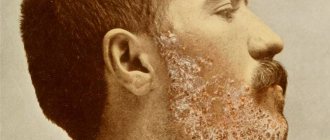Levomikol has long been known as an excellent wound-healing and anti-inflammatory agent with antimicrobial properties. Many patients are concerned about the question: is it possible to smear Levomekol in the mouth?
The ointment is used to treat purulent tissue damage and is applied directly to an open wound, in some cases even introduced into the cavity of the wound through a catheter. This means that the drug, if necessary, can be used on the mucous membranes, in particular for the treatment of wounds and inflammatory processes in the mouth
Quite often, doctors prescribe Levomekol to relieve inflammation during periodontal disease, apply compresses to the socket after tooth extraction, and treat damage in the corners of the mouth. The product helps well with sore gums.
Pharmacological properties
Levomekol contains two active ingredients:
- Chloramphenicol, which is a broad-spectrum antibiotic active against most gram-positive and gram-negative microorganisms, as well as rickettsia, spirochetes and chlamydia;
- Methyluracil is a drug that actively stimulates regeneration processes, helping to heal wound surfaces as quickly as possible and increase the body’s anti-infective defense.
The combination of these two medicinal substances provides a quick and most effective therapeutic effect of the drug Levomekol for stomatitis. Inflammatory processes occurring in the mouth, in particular on the gums, disappear within a few days, and relief occurs after several uses of the medicine.
Composition and price of the drug
"Levomekol" is a medicine with complex action. It contains the antibiotic chloramphenicol (0.0075 g) and the reparant methyluracil (0.04 g). Additionally, the composition includes polyethylene oxides 1500 and 400.
The drug is produced in the form of an ointment in tubes of various sizes - from 30 g to 50 g. The average cost per package of 40 g is 90 - 120 rubles.
"Levomekol" is used for flux due to its good anti-inflammatory and regenerative properties. It also draws out pus and accelerates the flow of exudate from the wound.
Important! The medicine is prescribed only after appropriate surgical treatment. It should not be used as the primary means of therapy.
The product is based on an antibiotic.
Indications for use
According to the instructions, Levomekol is used to treat the following pathologies:
- wound injuries (including purulent);
- inflammatory processes of purulent-necrotic type;
- inflammation of the lymph nodes (lymphadenitis);
- ulcerative and burn injuries to the skin;
- lesions caused by frostbite.
Levomekol is used in dental practice to treat:
- inflammatory processes of periodontium;
- gingivitis;
- fistulas caused by tooth extraction;
- purulent rashes associated with periostitis;
- postoperative injuries in the mouth;
- necrotic manifestations on the gums, with a prolonged inflammatory process.
Despite the fact that today there are many new dental products that relieve inflammation in the mouth, doctors often resort to using old and, most importantly, proven drugs. Levomekol is exactly such a medicine.
Use of the drug in childhood
For acne on the face, Levomekol is recommended for use by children over 3 years of age. It does not penetrate the blood and cannot have an effect on the child’s body. However, in difficult cases, doctors prescribe the ointment for infants.
Many infants have a heightened sense of smell and the effects of odor can be minimized by applying the product to gauze. It is important that when treating childhood acne, Levomekol should be applied in a very thin layer and not left on the skin for more than 15 minutes.
Contraindications
Levomekol ointment can be smeared in the mouth only if the patient has no contraindications to the medication, otherwise the use of the product can cause various allergic manifestations, including angioedema.
Levomekol is not used in the following cases:
- if the patient has hypersensitivity to the composition of the drug;
- if there is a history of psoriasis and eczematous skin lesions;
- in case of fungal infection.
If there are contraindications to the use of Levomekol, the patient is prescribed an analogue drug.
Features of use
The use of drugs, in particular Levomekol, in the area of the oral mucosa requires increased caution and careful study of the list of contraindications.
The ointment is not recommended for use simultaneously with sulfonamide components, with pyrazoline derivatives and with cytostatics.
The application of the medicine must be carried out in sterile cleanliness, thoroughly washing your hands and disinfecting the instruments used.
Instructions for use
Treatment of barley with Levomekol should be carried out only as prescribed by a doctor, since this drug is a universal remedy and may be ineffective without an integrated approach. The use of Levomekol ointment for barley on the eye is as follows:
- Wash your eyes with an antiseptic solution or chamomile decoction.
- With clean hands, apply a small amount of ointment to a sterile cotton pad or ear swab.
- For external inflammation, treat the swollen area with medicine, and for internal inflammation, slightly pull the affected eyelid and put a little ointment (about 1 cm) into the conjunctival sac. Drops are used in the same way.
- Close your eyes and sit like that for a few minutes. It is best to do the procedure before bed, since Levomekol provokes the formation of a film that impairs visibility.
Treatment of barley with Levomekol lasts 7-10 days. It is not recommended to use the drug for longer, as it is addictive.
Method of use
Levomekol is applied to the wound surface in a thin layer. Usually the drug is prescribed to be used 1 to 2 times a day for a course of no more than 5 days.
If necessary, the doctor may increase the duration of therapy.
Levomekol by mouth is used similarly to the standard regimen of use. After using the medication, it is advisable not to eat, drink liquids or rinse your mouth for some time. To treat fistulas, a sterile gauze bandage is soaked in ointment and placed in the damaged socket.
You can also apply a dressing soaked in the product to inflamed gums. As an option, sterile cotton wool is twisted into a tourniquet for a bandage.
If there are purulent wounds in the mouth, then they should simply be lubricated with a thin layer of Levomekol.
For traumatic postoperative injuries in the mouth, dressings soaked in Levomekol are applied to the previously washed wound for half an hour, after which they should be removed.
Pharmaceutical ointments for purulent, poorly healing wounds
Problematic wound healing with the formation of pus is caused by pathogens such as:
- streptococci;
- pseudomonas;
- staphylococci;
- mycobacteria.
In such cases, the typical signs of wound inflammation are sometimes accompanied by aching, throbbing or bursting pain, hyperemia and redness of the surrounding tissues. Then broad-spectrum antibacterial or bacterial ointments with an anti-inflammatory and regenerating effect are prescribed. Such agents may include analgesic components.
They are applied directly to the wound with clean fingers (it is necessary to treat your hands with a disinfectant solution) or with a napkin or tampon, avoiding contact of the tube with the wound. Store medications in a dark, cool place; After use, their shelf life is no longer than a month.
You can select an ointment for wound healing below from the proposed list of the best medicines from this group (the average cost in online pharmacies is indicated in parentheses, the price varies depending on the manufacturer).
Levomekol
The ointment (111-250 rubles) consists of two antimicrobial components to which most pathogenic microorganisms are sensitive - chloramphenicol and methylrucil. The latter has the additional property of increasing the natural immunity of cells.
Levomekol is the most popular, inexpensive and effective ointment for wound healing
Indications for use of the ointment are:
- furunculosis;
- carbunculosis;
- infected burns;
- trophic lesions;
- postoperative wounds;
- purulent-necrotic processes in tissues;
The product, in addition to individual intolerance to the substances, is contraindicated for eczema, fungal skin diseases and psoriasis.
Before using the drug, clean the wound with a liquid disinfectant and then spread a thin layer of ointment, placing a sterile bandage on top. The procedure is performed 4 times a day until complete recovery.
Vishnevsky ointment
This drug (9-71 rubles) is a combination of bismuth tribromophenolate with natural ingredients: birch tar and castor oil.
The medicine has antiseptic and regenerating properties and is prescribed in the following cases:
- burns, bedsores;
- surgical wounds;
- chronic endarteritis;
- tissue trophic disorders;
- skin infectious diseases (abscesses, boils), psoriasis.
In addition to personal intolerance to individual components, the drug is contraindicated for cysts, proctitis and lipomas, and renal disorders. Due to the fact that the drug contains a photosensitizing component - birch tar, it is not used on unprotected areas of the body in the spring-summer season, since it increases the skin's sensitivity to ultraviolet radiation and can cause sunburn.
The balm should be applied in a small layer, avoiding contact with the mucous cavity of the skin, twice a day, then covering the treated area with a multi-layer bandage.
Syntomycin ointment
The active component of the ointment (38-97 rubles) is syntomycin. The principle of action of the substance is to suppress the synthesis of proteins of pathogens: staphylococci and streptococci, as well as a number of gram-negative bacteria that cause the following disorders:
- burns (up to III degree);
- cracked nipples during lactation;
- long-term non-healing trophic ulcers;
- infectious inflammation of the skin with purulent contents.
Do not use the product for fungal infections or dermatoses. Liniment is applied to painful areas with a gauze pad. A bandage is applied on top. Depending on the severity of the lesion, dressings are done once every 1-3 days for a period selected individually (1-2 weeks).
Ichthyol ointment
Ointment (52-135 rubles) based on paraffin with ichthyol has an anti-inflammatory, local anesthetic and bactericidal effect. In addition, this remedy accelerates the release of purulent exudate from pustules, so that in the initial stages various formations can resolve naturally, without surgical intervention.
Indications for its use are closed (not bleeding) wounds, erysipelas, eczema.
It is not recommended to apply the product to open purulent wounds and mucous membranes.
A small amount of the drug is applied with clean fingers to the sore skin and covered with a bandage; the procedure is carried out 2-3 times a day. The course of treatment is determined individually as you recover.
Edas-202m
This is a combined homeopathic remedy (90-154 rubles), consisting of extracts of belladonna, echinacea, marigold, chamomile and heparsulfur.
There are a wide range of indications for its use:
- trophic ulcers;
- burns, dermatoses;
- abrasions, diaper rash;
- various skin wounds with the formation of pus and itching.
The product usually does not cause adverse reactions; In rare cases, a rash may occur if you are allergic to one of the components. Apply the ointment to damaged areas of the skin three times a day, in a thin layer.
Use in pediatrics and pregnant patients
Levomekol is approved for use in children from the age of three. The method of using the medicine for them remains the same as for an adult.
Before starting to take the drug in a child, especially in the mouth, you must consult with your doctor and make sure there are no contraindications.
The use of Levomekol during pregnancy and breastfeeding is prescribed only when absolutely necessary. This is due to the fact that there have not been a sufficient number of clinical trials in this group of patients and there is no data on the possible effects on the health of the expectant mother and intrauterine development of the fetus.
Pharmacology of Levomekol ointment
This drug has long been known in medicine as an excellent wound-healing ointment with a pronounced anti-inflammatory effect. Levomekol ointment is a combination product based on an antibiotic and beneficial components. This is one of the few pharmacological formulas that have been tested for decades and have not undergone changes.
Levomekol in dentistry and other branches of medicine is valued by specialists for the following properties:
- regenerating;
- antimicrobial;
- anti-inflammatory;
- healing;
- tonic.
The ointment is used to treat purulent and infected wounds of the mucous membrane in the mouth and on the skin of the body. It can be applied to bumps in the corners of the mouth, and to lubricate cracks on the lips during thrush. This is the most optimal option for eliminating inflammation in periodontal disease and gingivitis, the basis for compresses on the fistulous tract or hole after tooth extraction.
Side effects
To carry out therapy, you can smear your mouth with Levomekol only if the patient has no contraindications to the medication. If there is hypersensitivity to the components of the drug, allergic reactions may develop, manifested in the form of:
- rash reactions;
- itching and burning sensation in the mouth;
- swelling;
- local redness of tissues;
- Quincke's edema.
If the above or any other uncomfortable sensations develop during therapy. It is necessary to stop using the product and seek advice from a specialist doctor.
